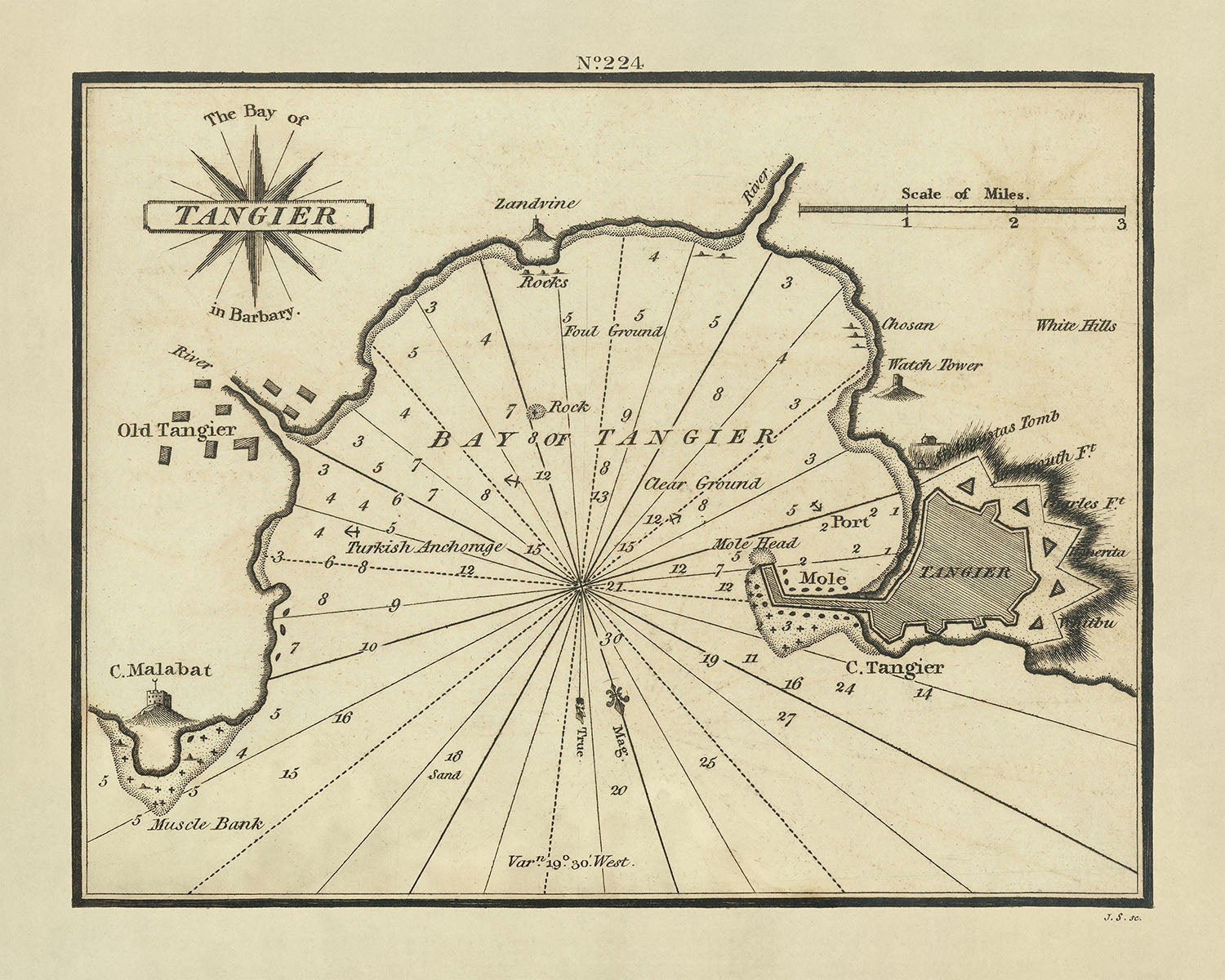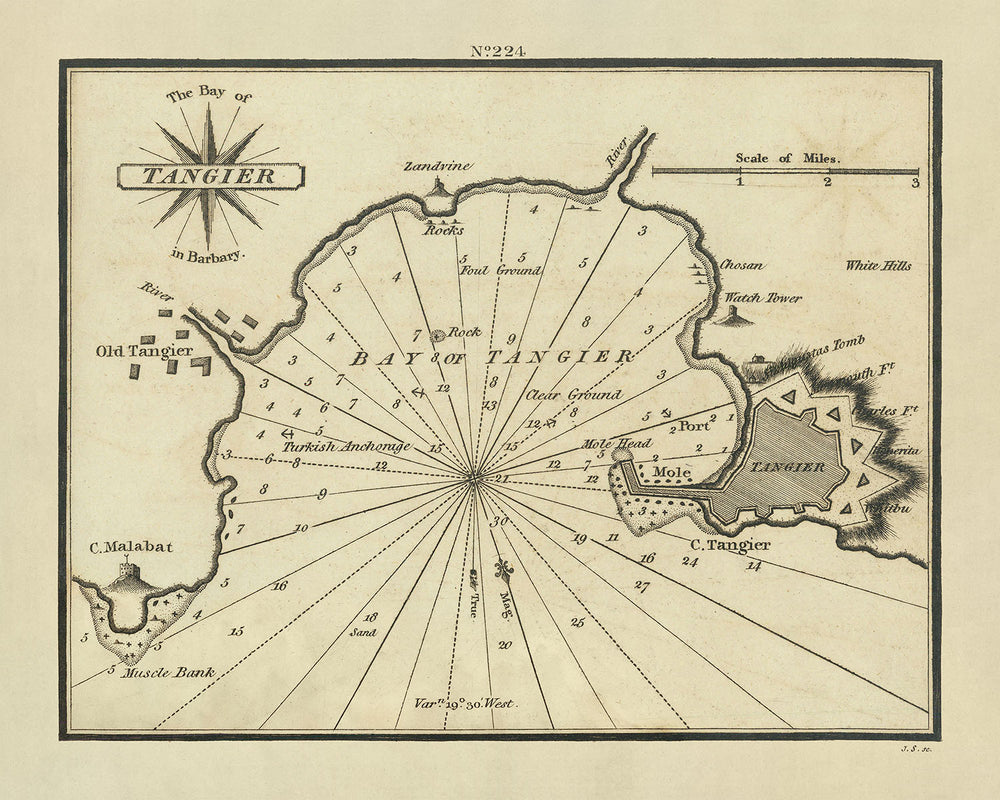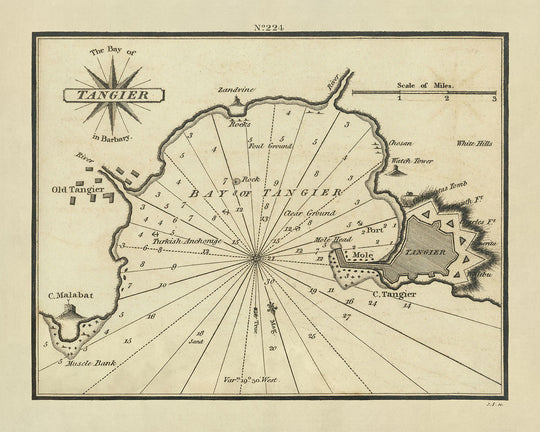- Handmade locally. No import duty or tax
- FREE Delivery by Christmas
- Love it or your money back (90 days)
- Questions? WhatsApp me any time
Own a piece of history
5,000+ 5 star reviews


The Bay of Tangier: A Rare Cartographic Masterpiece
The Bay of Tangier map, engraved in 1802 by the esteemed London publisher William Heather, represents a significant piece in the history of cartography. This rare chart, part of Heather's "The New Mediterranean Pilot," marks a pivotal English endeavor to document the Mediterranean's ports—a venture previously dominated by French, Italian, and Spanish cartographers. The map, with its meticulous engravings signed by John Stephenson, stands out for its precision and artistic quality, contrasting sharply with the more rudimentary charts produced by Heather's continental contemporaries. Oriented with south at the top, it provides a unique perspective of Tangier, Morocco, highlighting its strategic maritime importance through detailed soundings, topographical features, and anchorages.
Navigational and Topographical Details
This finely crafted chart offers more than just a geographical representation; it serves as a vital navigational tool with its detailed soundings and anchorages clearly marked. The inclusion of these elements not only guided mariners safely into the bay but also reflected the evolving needs of naval and merchant shipping during the early 19th century. The map meticulously documents various landmarks of Tangier, from the bustling port and the historic Mole Head to the strategic Turkish Anchorage and the surrounding hills, providing a comprehensive view of the area's maritime landscape.
Historical and Military Significance
Beyond its navigational utility, the map is a treasure trove of historical insights, particularly into Tangier's rich military heritage. It details the locations of multiple forts built by different colonial powers through the centuries, including Portuguese, English, Spanish, French, and American forts. Each fort's placement underscores the bay's geopolitical significance and the tumultuous history of control over this strategic North African port. The map also marks the site of the Battle of Tangier (1471), adding a layer of historical depth to its already rich cartographic narrative.
Artistic and Aesthetic Appeal
The artistic merit of "The Bay of Tangier" chart is undeniable. Each line and lettering is finely engraved, reflecting the high standards of London's engraving work at the time, spearheaded by talents like John Stephenson. The map's aesthetic, with its detailed coastal lines and textured representation of the hilly terrains, not only serves a practical purpose but also makes it a visually appealing artifact. This chart is not merely a tool for navigation but a work of art, suitable for both study and display in any collection of fine maps.
Rarity and Collector's Value
Given its scarcity and the craftsmanship it exhibits, "The Bay of Tangier" is a prized possession for collectors and historians alike. As one of the rare charts from Heather's "The New Mediterranean Pilot," it holds significant value not only for its artistic and historical qualities but also as a specimen of early 19th-century English cartographic ambition. The map's rarity is enhanced by its condition and the fact that such charts seldom appear on the market, making it an exceptional find for enthusiasts of rare maps and maritime history.
What can be seen on this map
- The Bay of Tangier
- Old Tangier
- C. Malabat
- Muscle Bank
- C. Tangier
- Tingier
- Mole
- Port
- Mole Head
- Clear Ground
- Turkish Anchorage
- Rock
- Fout Ground
- Rocks
- Zandvine
- Chosan
- White Hills
- Watch Tower
- South Ft
- Atas Tomb
- River
- Sand
Notable Features & Landmarks
- The city of Tangier, located on the western side of the bay
- The old city of Tangier, located on the eastern side of the bay
- The location of the Battle of Tangier, which took place in 1471
- Portuguese Fort, built in the 15th century
- English Fort, built in the 17th century
- Spanish Fort, built in the 18th century
- French Fort, built in the 19th century
- American Fort, built in the 20th century
- Italian Fort, built in the 21st century
Historical and design context
- Rare antique engraved chart of Tangier, Morocco, published by William Heather in London
- Part of Heather's "The New Mediterranean Pilot," the first English attempt at a collection of ports of the Mediterranean
- Notable for the finely engraved charts, many signed in monogram by the London engraver John Stephenson
- Oriented with south at the top
- Includes soundings, some topographical features, and anchorages
- Reflects the high standards of London's engraving work at the time
Please double check the images to make sure that a specific town or place is shown on this map. You can also get in touch and ask us to check the map for you.
This map looks great at every size, but I always recommend going for a larger size if you have space. That way you can easily make out all of the details.
This map looks amazing at sizes all the way up to 50in (125cm). If you are looking for a larger map, please get in touch.
The model in the listing images is holding the 16x20in (40x50cm) version of this map.
The fifth listing image shows an example of my map personalisation service.
If you’re looking for something slightly different, check out my collection of the best old maps to see if something else catches your eye.
Please contact me to check if a certain location, landmark or feature is shown on this map.
This would make a wonderful birthday, Christmas, Father's Day, work leaving, anniversary or housewarming gift for someone from the areas covered by this map.
This map is available as a giclée print on acid free archival matte paper, or you can buy it framed. The frame is a nice, simple black frame that suits most aesthetics. Please get in touch if you'd like a different frame colour or material. My frames are glazed with super-clear museum-grade acrylic (perspex/acrylite), which is significantly less reflective than glass, safer, and will always arrive in perfect condition.
This map is also available as a float framed canvas, sometimes known as a shadow gap framed canvas or canvas floater. The map is printed on artist's cotton canvas and then stretched over a handmade box frame. We then "float" the canvas inside a wooden frame, which is available in a range of colours (black, dark brown, oak, antique gold and white). This is a wonderful way to present a map without glazing in front. See some examples of float framed canvas maps and explore the differences between my different finishes.
For something truly unique, this map is also available in "Unique 3D", our trademarked process that dramatically transforms the map so that it has a wonderful sense of depth. We combine the original map with detailed topography and elevation data, so that mountains and the terrain really "pop". For more info and examples of 3D maps, check my Unique 3D page.
For most orders, delivery time is about 3 working days. Personalised and customised products take longer, as I have to do the personalisation and send it to you for approval, which usually takes 1 or 2 days.
Please note that very large framed orders usually take longer to make and deliver.
If you need your order to arrive by a certain date, please contact me before you order so that we can find the best way of making sure you get your order in time.
I print and frame maps and artwork in 23 countries around the world. This means your order will be made locally, which cuts down on delivery time and ensures that it won't be damaged during delivery. You'll never pay customs or import duty, and we'll put less CO2 into the air.
All of my maps and art prints are well packaged and sent in a rugged tube if unframed, or surrounded by foam if framed.
I try to send out all orders within 1 or 2 days of receiving your order, though some products (like face masks, mugs and tote bags) can take longer to make.
If you select Express Delivery at checkout your order we will prioritise your order and send it out by 1-day courier (Fedex, DHL, UPS, Parcelforce).
Next Day delivery is also available in some countries (US, UK, Singapore, UAE) but please try to order early in the day so that we can get it sent out on time.
My standard frame is a gallery style black ash hardwood frame. It is simple and quite modern looking. My standard frame is around 20mm (0.8in) wide.
I use super-clear acrylic (perspex/acrylite) for the frame glass. It's lighter and safer than glass - and it looks better, as the reflectivity is lower.
Six standard frame colours are available for free (black, dark brown, dark grey, oak, white and antique gold). Custom framing and mounting/matting is available if you're looking for something else.
Most maps, art and illustrations are also available as a framed canvas. We use matte (not shiny) cotton canvas, stretch it over a sustainably sourced box wood frame, and then 'float' the piece within a wood frame. The end result is quite beautiful, and there's no glazing to get in the way.
All frames are provided "ready to hang", with either a string or brackets on the back. Very large frames will have heavy duty hanging plates and/or a mounting baton. If you have any questions, please get in touch.
See some examples of my framed maps and framed canvas maps.
Alternatively, I can also supply old maps and artwork on canvas, foam board, cotton rag and other materials.
If you want to frame your map or artwork yourself, please read my size guide first.
My maps are extremely high quality reproductions of original maps.
I source original, rare maps from libraries, auction houses and private collections around the world, restore them at my London workshop, and then use specialist giclée inks and printers to create beautiful maps that look even better than the original.
My maps are printed on acid-free archival matte (not glossy) paper that feels very high quality and almost like card. In technical terms the paper weight/thickness is 10mil/200gsm. It's perfect for framing.
I print with Epson ultrachrome giclée UV fade resistant pigment inks - some of the best inks you can find.
I can also make maps on canvas, cotton rag and other exotic materials.
Learn more about The Unique Maps Co.
Map personalisation
If you're looking for the perfect anniversary or housewarming gift, I can personalise your map to make it truly unique. For example, I can add a short message, or highlight an important location, or add your family's coat of arms.
The options are almost infinite. Please see my map personalisation page for some wonderful examples of what's possible.
To order a personalised map, select "personalise your map" before adding it to your basket.
Get in touch if you're looking for more complex customisations and personalisations.
Map ageing
I have been asked hundreds of times over the years by customers if they could buy a map that looks even older.
Well, now you can, by selecting Aged before you add a map to your basket.
All the product photos you see on this page show the map in its Original form. This is what the map looks like today.
If you select Aged, I will age your map by hand, using a special and unique process developed through years of studying old maps, talking to researchers to understand the chemistry of aging paper, and of course... lots of practice!
If you're unsure, stick to the Original colour of the map. If you want something a bit darker and older looking, go for Aged.
If you are not happy with your order for any reason, contact me and I'll get it fixed ASAP, free of charge. Please see my returns and refund policy for more information.
I am very confident you will like your restored map or art print. I have been doing this since 1984. I'm a 5-star Etsy seller. I have sold tens of thousands of maps and art prints and have over 5,000 real 5-star reviews. My work has been featured in interior design magazines, on the BBC, and on the walls of dozens of 5-star hotels.
I use a unique process to restore maps and artwork that is massively time consuming and labour intensive. Hunting down the original maps and illustrations can take months. I use state of the art and eye-wateringly expensive technology to scan and restore them. As a result, I guarantee my maps and art prints are a cut above the rest. I stand by my products and will always make sure you're 100% happy with what you receive.
Almost all of my maps and art prints look amazing at large sizes (200cm, 6.5ft+) and I can frame and deliver them to you as well, via special oversized courier. Contact me to discuss your specific needs.
Or try searching for something!















































